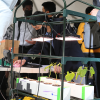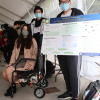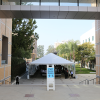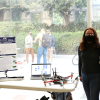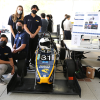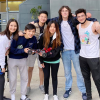Revitalized Fall Design Review Showcases Students’ Ingenuity
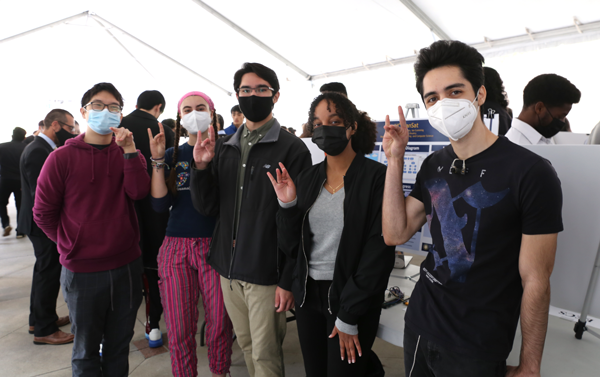
Dec. 16, 2021 - The Samueli School’s Engineering Gateway Plaza bustled with energy, enthusiasm and purpose on Dec. 3, as nearly 800 engineering undergraduates gathered for the 2021 Fall Design Review. This year’s in-person event included 177 teams from five of the school’s six departments.
The annual showcase is the first chance for senior engineering students to present their design project goals to a wider audience. The students shared project posters and prototypes with peers, faculty and industry guests. The day was split into two sessions with the morning featuring teams from electrical engineering and computer science, and civil and environmental engineering, and the afternoon presenting teams from biomedical engineering, materials science and engineering, and mechanical and aerospace engineering.
Stacey Nicholas Dean of Engineering Magnus Egerstedt welcomed everyone and kicked off the eighth annual event. “I’m really excited to be here. I love that engineering is not a myopic discipline, and this design review provides a chance for our faculty and industry friends to see the interdisciplinary aspect of our students’ work. At the end of the day, the real value of an Anteater education is in these hands-on experiences.”
The ZotPonics 3.0 team was eager to show and explain their plan to build a smart, cost-efficient and scalable indoor hydroponics system that would provide fresh produce to students on campus at the FRESH Basic Needs Hub. The project is in its second year of iteration under the guidance of Quoc-Viet Dang, professor of teaching in electrical engineering and computer science. This year’s team is fine-tuning the mobile app, which controls the system. They are adding features such as social media integration, search engine optimization and plant statistics. “We’re growing baby spinach and green beans and creating settings for each plant on the mobile app,” said Daniel Lowe, computer science engineering major.
Civil engineering students Jiaxin Fei and Xochitl Arquieta created a design for sustainable redevelopment of historic Old Town Orange, which deals with problems of high traffic levels and low housing quality. Their project suggested adding bus routes, repurposing old buildings and adding green areas and lighting at the train station. Their goal was to make the area safer, more efficient and reduce pollution. “I learned a lot about engineering systems – structures, transportation and water delivery,” said Fei.
Christopher Kim and Jacob Calendine were part of a biomedical engineering-materials science engineering team that is designing a cardiac energy harvesting device. The students’ device would use the mechanical pumping of the heart to create electricity through electromagnetic induction. The electricity would then be used to power a pacemaker, lengthening the life of an implantable pacemaker. Their device consists of a sleeve, magnets and a stent. The stent is connected to the magnets and moves with the contracting motion of the heart. The motion of the magnets causes electromagnetic induction to occur in the copper coil sleeve to then recharge the pacemaker.
Sky Hargrove, a third-year mechanical engineering major, is going on year two as a member of the UCI Rocket Project, and this year, she is a co-lead of the propulsion team. The UCI Rocket Project is an undergraduate student team pushing the boundaries of collegiate rocketry through the design and fabrication of liquid-fueled rockets.
“I received on email during COVID, and I knew I wanted to get involved in something. It is an exciting project,” she said. Five team members recently attended a rocket launch event hosted by the Rocketry Organization of California (ROC) at the Lucerne Dry Lake. They were able to launch their own test rockets and get an idea of the logistics and preparation required for the planned spring quarter launch of a liquid-fueled rocket.
While senior engineering students gathered at one end of Gateway Plaza, first-year students from the Samueli School’s Introduction to Engineering class congregated at the other end. Now in its 10th year, the class gives students a hands-on engineering experience by teaching them the design process, which they then apply to a project. This year, 279 students, in teams of five to seven, designed, built and tested remote-controlled rovers. Team Zotter Bots won the final competition by completing the obstacle course in 17.91 seconds. Two teams, Peter McQueen and Foreigneers, tied for second place at 18.66 seconds, and the Avengineers came in third at 18.97 seconds.
“This is a great turnout for Fall Design Review, both sessions,” said Megan Sosa, Samueli School events manager. “Everyone seems happy to be here and proud to showcase their projects. I’m excited to see how they all develop at our next event, Winter Design Review, on March 11, 2022.”
– Lori Brandt



